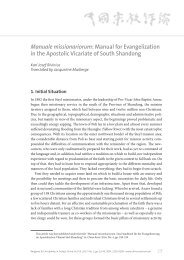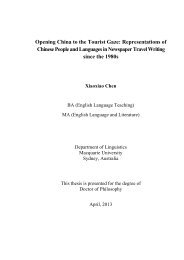EDUCATION IN CHINA
Education-in-China-a-snapshot
Education-in-China-a-snapshot
Create successful ePaper yourself
Turn your PDF publications into a flip-book with our unique Google optimized e-Paper software.
Chapter 1 – Organisation and management of education in China<br />
principals (Ministry of Education, 2012). In 2014, the<br />
Ministry of Education implemented the National Training<br />
Programme for Primary and Secondary School Principals.<br />
This plan aims at training a group of leaders to implement<br />
quality education, promote reforms and develop basic<br />
education in rural areas, especially outlying and povertystricken<br />
areas. The programme also aims at training a<br />
group of outstanding principals, especially principals<br />
who have backgrounds as educators. Officials charged<br />
these principals with drawing on advanced education<br />
philosophy in order to innovate school practices, and<br />
serving as role models for other principals. This plan<br />
consists of various projects including the Rural Principals<br />
Assistance Projects in Remote and Poor Areas, the Ability<br />
Improvement Project for Special Education School<br />
Principals and the Outstanding Principal Pilot Project.<br />
The government has established sabbatical leave for<br />
headmasters and teachers in primary and secondary<br />
schools only recently. Under this new system, outstanding<br />
teachers and headmasters may take a half-year sabbatical<br />
leave every five years. During this period, the teacher or<br />
headmaster can join study programmes abroad.<br />
Other systems like the Teaching Study Group System<br />
and the Lesson Observation and Evaluating System serve<br />
a similar function to the training system. Under the<br />
Teaching Study Group system, every teacher is a member<br />
of a teaching study group. These groups are created<br />
according to each teacher’s teaching subject and grade,<br />
which means that all the teachers who teach the same<br />
subject in the same grade form a teaching study group. In<br />
the group, detailed and practical subject teaching plans<br />
are designed at the beginning of the semester, so that<br />
every teacher who teaches the same content follows a<br />
similar schedule. Lesson preparation is completed partly<br />
by individual teachers, and partly via collaborative effort<br />
in the teaching study group. During group sessions,<br />
teachers analyse textbooks, determine key points and<br />
discuss the best teaching approach. The teaching study<br />
group also has the function of consolidating teaching<br />
experience and increasing the quality of teaching.<br />
Indeed, successful teaching study group experiences are<br />
published frequently in educational journals or teacher<br />
magazines in China. In the teaching study group system,<br />
experienced and outstanding teachers often serve as<br />
leaders of the groups. Thus other teachers, especially<br />
new teachers, can learn from the experienced teachers<br />
and improve their teaching skills through daily work. The<br />
Lesson Observation and Evaluating System is to some<br />
degree both a supervision system and a learning system<br />
since it requires every teacher to observe other teachers’<br />
teaching and lesson planning and give feedback. For<br />
new teachers, this is also a good way to learn from<br />
experienced teachers, while for experienced teachers,<br />
this is a good way to supervise new teachers and give<br />
them suggestions.<br />
PROMOTION AND REWARD<br />
Teachers in China are ranked by professional grades.<br />
Different professional titles are set for both primary<br />
and secondary teachers. In the last five years, the title<br />
system has undergone a reform to create a unified title<br />
system. A new highest title has been added. Teachers in<br />
both primary and junior secondary schools use the same<br />
title system, which has expanded teachers’ opportunities<br />
for professional development, and elevated their social<br />
status. Professional titles are listed in Table 1.2 with the<br />
professional requirements, in descending order.<br />
There are a fixed number of posts in each professional<br />
title, which implies that promotion processes can be<br />
competitive. Mostly, the teacher must have enough<br />
publications and awards to receive a promotion, though<br />
this is not an official requirement. This informal standard<br />
can be quite challenging and unfair to teachers in rural<br />
areas. However, in 2015, the Rural Teacher Support<br />
Programme was initiated. The programme was designed<br />
to support the promotion of teachers in rural areas<br />
by excluding publication and foreign language skills<br />
from consideration. Promotions are issued by the same<br />
institutions that recruit teachers, and are managed by<br />
government at the county level and above, or by the<br />
schools in some cases.<br />
Special-Grade Teacher is also a title for primary and<br />
secondary teachers. It is not a professional title, but an<br />
honour. It was specially established for very outstanding<br />
teachers. The teachers who win the title are supposed<br />
to be role models for teachers, and experts in education.<br />
The number of special-grade teachers should be within<br />
15% of the total number of all teachers.<br />
20 – <strong>EDUCATION</strong> <strong>IN</strong> CH<strong>IN</strong>A: A SNAPSHOT © OECD 2016





